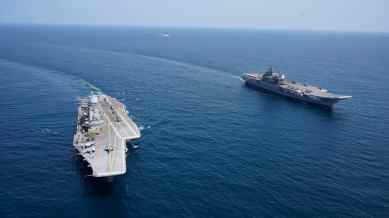Highest Direct Tax-paying Companies: The highest tax-paying companies have accounted for nearly 19% of the government's provisional gross corporate tax collection, totalling Rs 2.2 lakh crore in 2024.
Among world’s top 10 biggest aircraft carriers, 2 are from India
Here are the world's top 10 biggest aircraft carriers are a testament to the technological advancements and naval prowess of the nations that operate them.

List of the 10 world’s biggest aircraft carriers: Aircraft carriers are the most powerful and versatile warships in modern naval fleets, serving as floating air bases capable of projecting air power across vast expanses of the ocean, with their eminence having been proven since World War I.
Recently, as per the Naval News, China has reportedly launched the world’s first dedicated drone aircraft carrier by the name of Fujian Type 076, according to satellite imagery and an expert from the Jiangnan Shipyard on the Yangtze River. The launch was not reported until now and has raised questions about China’s intentions to advance the military use of drones and their deployment in battle.
monthly limit of free stories.
with an Express account.
Today, as aircraft carriers remain the centrepiece of naval forces, providing unparalleled power projection capabilities and serving as symbols of national prestige and military might; here are the top 10 biggest aircraft carriers in the world.
The world’s top 10 biggest aircraft carriers
| Rank | Name | Country |
| 1 | Gerald R. Ford Class | United States |
| 2 | Nimitz Class | United States |
| 3 | Queen Elizabeth Class | United Kingdom |
| 4 | Admiral Kuznetsov | Russia |
| 5 | Fujian | China |
| 6 | Shandong | China |
| 7 | Liaoning | China |
| 8 | INS Vikramaditya | India |
| 9 | Charles de Gaulle | France |
| 10 | INS Vikrant | India |
Source: Naval Technology
1. USS Gerald R. Ford Class (CVN-78), USA:
The USS Gerald R. Ford class is the largest aircraft carrier in the world, with a displacement of 100,000 tons. The first ship, USS Gerald R. Ford (CVN 78), was delivered to the US Navy in May 2017 and became operational in December 2021 after initial service entry in July 2017. It recently completed a six-month modernisation and maintenance period in March 2022. The carrier features a state-of-the-art electromagnetic launch system on its 78-metre flight deck, supports over 75 aircraft, and houses 4,539 personnel. It’s powered by two A1B nuclear reactors and equipped with advanced defensive systems like the RIM-162 missiles and Phalanx CIWS.
2. Nimitz Class, USA:
The Nimitz class carriers, with a displacement of 97,000 tonnes, rank as the second-largest aircraft carriers globally. The first of this class launched in May 1975, and the fleet has expanded to ten ships, the latest being USS George HW Bush, commissioned in January 2009. The USS George Washington and USS John C. Stennis are currently undergoing mid-life overhauls to extend their operational lives by another 25 years. These carriers feature a massive 4.5-acre flight deck and can accommodate over 5,000 personnel.
3. Queen Elizabeth Class, UK:
The Queen Elizabeth class is the largest warship built for the Royal Navy, displacing 65,000 tons. HMS Queen Elizabeth, the lead ship, was commissioned in December 2017 and completed its maiden seven-month operational deployment in December 2021. The second ship, HMS Prince of Wales, was commissioned in December 2019 and participated as a NATO command ship in 2022. These carriers can support up to 40 aircraft and use advanced Rolls-Royce MT30 gas turbines and diesel generators for propulsion.
4. Admiral Kuznetsov, Russian Federation:
5. Fujian, China:
China’s third aircraft carrier, Fujian, launched in June 2022, is set to be its most advanced, with a displacement exceeding 80,000 tons. It is the first Chinese carrier equipped with electromagnetic catapults, marking a significant technological advancement over the ski-jump systems used on earlier ships.
6. Shandong, China:
Commissioned in December 2019, the Shandong is China’s first domestically built aircraft carrier and the second in active service. With improvements over its predecessor, Liaoning, Shandong features a larger flight deck and enhanced aircraft capacity, highlighting China’s growing capabilities in naval architecture.
7. Liaoning, China:
The Liaoning, a refitted Soviet-era carrier, was commissioned by China in September 2012. It has a displacement of over 58,000 tonnes and carries approximately 50 aircraft. Its armament includes CIWS and surface-to-air missiles, enhancing its defensive capabilities.
8. INS Vikramaditya, India:
The INS Vikramaditya, India’s significant naval asset, is a modified Kiev-class carrier acquired from Russia and commissioned in November 2013. It displaces 44,500 tonnes and can carry over 30 aircraft. Its robust armament and advanced propulsion system make it a cornerstone of India’s maritime force.
9. Charles de Gaulle (R91), France:
France’s Charles de Gaulle (R91), the only nuclear-powered carrier outside the US, underwent a significant refit in 2013. It displaces 42,000 tonnes and can support 40 aircraft, including advanced Rafale M fighters. Powered by two nuclear reactors, it offers substantial speed and power, underscoring France’s maritime capabilities.
Top 10 richest women in the world in 2024: Where does India’s Savitri Jindal stand?
10. INS Vikrant, India:
India’s first indigenously built aircraft carrier, INS Vikrant, launched in August 2013 and set for commissioning in August 2022, can operate up to 40 aircraft. This carrier represents a major step forward in India’s naval self-reliance, featuring sophisticated weapon systems and a STOBAR mechanism for aircraft operations.